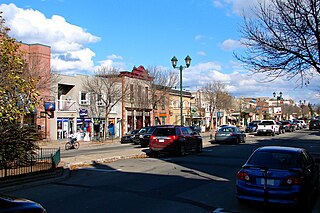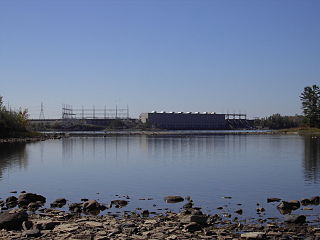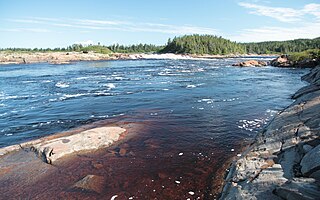
The Saguenay River is a major river of Quebec, Canada. It drains Lac Saint-Jean in the Laurentian Highlands, leaving at Alma and running east; the city of Saguenay is located on the river. It drains into the Saint Lawrence River. Tadoussac, founded as a French colonial trading post in 1600, is located on the northeast bank at this site.

The Montmorency Falls is a large waterfall on the Montmorency River in Quebec, Canada.
An ace is a playing card.

Lachute is a town in southwest Quebec, Canada, 62 km (39 mi) northwest of Montreal, on the Rivière du Nord, a tributary of the Ottawa River, and west of Mirabel International Airport. It is located on Autoroute 50, at the junctions of Quebec Provincial Highways Route 148, Route 158, and Secondary Highways 327 and 329.
Haha or ha ha is an onomatopoeic representation of laughter.

The Saint-Maurice River flows North to South in central Quebec from Gouin Reservoir to empty into the Saint Lawrence River at Trois-Rivières, in the province of Quebec, in Canada. From its source at Gouin Reservoir, located at the same latitude as the Lac Saint-Jean, the river has a total drop of about 405 meters (1330'), to finally reach the St. Lawrence river at Trois-Rivières. The river is 563 km in length and has a drainage basin of 43,300 km². Saint-Maurice river is one of the most important tributaries of the St. Lawrence river.
Des chutes is French for of the falls, referring to waterfalls or rapids.

The Coulonge River is a predominantly wilderness river in western Quebec, Canada. One of a dozen or so significant tributaries of the Ottawa River, it has a length of 240 kilometres (150 mi) and a drainage area of 5,060 square kilometres (1,950 sq mi), and runs in a general south-eastern direction from its headwaters in Lac au Barrage to the Ottawa River at Fort-Coulonge. Over that distance, it drops approximately 260 meters (850 ft) — 48 meters (157 ft) of that over the massive Grandes or Coulonge Chutes, approximately 15 kilometers (9.3 mi) upstream of the confluence with the Ottawa River.
Charbonneau may refer to:
Thousand Islands constitute an archipelago that straddles the Canada-U.S. border in the Saint Lawrence River.

Grenville-sur-la-Rouge is a municipality in the Argenteuil Regional County Municipality in the Laurentides region of Quebec, Canada. It is a predominantly Francophone community situated along the southern border of Quebec between Montreal and Ottawa.

Chats Falls were a set of waterfalls on the Ottawa River, near Fitzroy Harbour, Ontario, and Quyon, Quebec, Canada. A hydroelectric generating station is now located here, owned and operated jointly by Hydro-Québec and Ontario Power Generation. It lies within the cities of Ottawa, Ontario and Pontiac, Quebec.
Chutes-de-la-Chaudière or Chutes de la Chaudière may refer to:
Pins is the plural of "pin", a fastening device.
The Rivière des Chutes drains mainly the municipality of Saint-Narcisse, and also Saint-Stanislas, at the end of its course. These municipalities are located in the Les Chenaux Regional County Municipality, in the administrative region of Mauricie, in the province of Quebec, Canada.

The Manitou River is a river flowing in the unorganized territory of Lac-Jérôme and in the municipality of Rivière-au-Tonnerre, in the Minganie Regional County Municipality, in the Côte-Nord region in the province of Quebec, Canada.

The Aguanish River is a salmon river of the Côte-Nord region of Quebec. It flows from north to south and empties into the Gulf of Saint Lawrence.
This page is based on this
Wikipedia article Text is available under the
CC BY-SA 4.0 license; additional terms may apply.
Images, videos and audio are available under their respective licenses.








